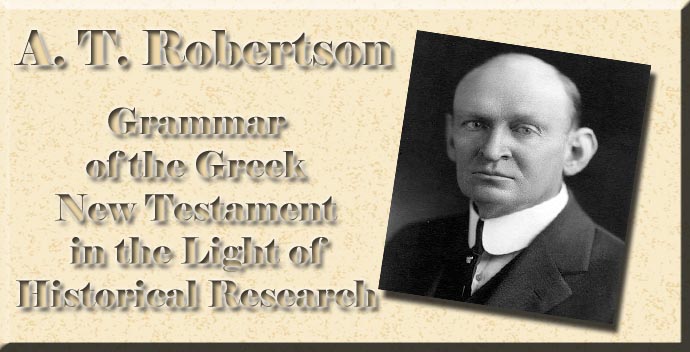
Grammar of the Greek New Testament in the Light of Historical Research
By A. T. Robertson
Preface to Third Edition
|
MY grammar has had to live and do its work in spite of the Great War, but the time for the Third Edition has come. In a letter Dr. Alfred Plummer says: "That so technical and expensive a volume should be already in a third edition in the fifth year of the war is indeed triumphant evidence of the value of the book. Scientific grammar is appreciated more widely than one would antecedently have ventured to expect." These few years have allowed time for a thorough verification of the multitudinous references. This enormous task has been done as a labor of love by Mr. H. Scott, of Birkenhead, England, whose patient skill has placed all users of the book under a debt of gratitude that can never be paid. He had already put his invaluable services at my disposal, but now his leisure permitted him to employ his really wonderful statistical knowledge of the Greek New Testament for the benefit of students. These extremely useful tables are found in the Addenda to this Edition. I am sure that all New Testament students will appreciate and profit greatly from these tables. A brilliant student of mine, Rev. W. H. Davis, has found some striking illustrations in the papyri that appear in the Addenda, besides a number from my own readings. Dr. Davis is at work on the lexical aspects of the papyri and the inscriptions. If his studies lead him on to prepare a New Testament lexicon, the world will be the better for such an outcome. Mr. J. F. Springer, of New York City, has also made some valuable contributions which appear in the Addenda. I am indebted also to Prof. Robert Law, of Knox College, Toronto, for errata.
I have watched with eagerness for criticisms of the book and
have done my best to turn them to the improvement of the
grammar.
It is gratifying to know that ministers are using it in their
studies as one of the regular tools in the shop. In the
classroom
only selected portions can be covered; but the preacher can use
it
every day (as many do) in his reading and study of the Greek
New Testament. There are many ministers who read the Greek
New Testament through once a year, some of it every day, besides
the solid, critical study of a Gospel or Epistle with
commentary,
lexicon and grammar. This is the work that pays one a
hundredfold in his preaching. My own reward for the long years
of devotion to this grammar is found in the satisfaction that
scholarly ministers are using the book for their own enrichment.
I have been gratified to learn of laymen who use the book
regularly.
Besides the correction of infelicities and errata that could be
found here and there and the Addenda at the end of the volume
I have inserted a detailed Table of Contents which will greatly
aid one in finding topics in the various chapters. The minute
subdivisions with page references will supplement the various
Indices to great advantage. The Index of Greek words, large as
it is, was still incomplete. It has been doubled in this edition
by
Mr. Scott's assistance. The Additional Bibliography records the
most important recent contributions.
Death has been busy with New Testament linguists. Dr. Gross
Alexander, of Nashville, has been claimed by death. Dr. George
Heinrici, of Leipzig, is dead. Dr. Albert Thumb, of Marburg, has
likewise passed on. Dr. H. B. Swete, of Cambridge, and Principal
James Denney, of Glasgow, have also joined the great majority.
These are irreparable losses, but there are others and even
greater
ones. Dr. Caspar Rene Gregory, of Leipzig, though seventy years
old, volunteered for the army and was killed in battle in
France.
With his death perished the hope of a new and revised edition of
Tischendorf's
Dr. James Hope Moulton fell a victim in April, 1917, in the
Mediterranean Sea, to the German submarine. He was placed in
a boat, but after several days succumbed to the exposure and
cold. It was he who first applied in detail Deissmann's
discovery
that the New Testament was written in the current
The workers die, but the work goes on. It is pleasant to think
that Greek is renewing its grip upon the world. Professors
Stuart
and Tewksbury are preparing a grammar and lexicon for Chinese
students of the New Testament. Japan will do likewise. Prof.
H. P. Houghton, of Waynesburg College, Pennsylvania, is
confident
that Greek can be saved for the college and the university,
for "it is the basis of true culture" (
At the age of sixteen John Brown, of Haddington, startled a
bookseller by asking for a copy of the Greek Testament. He was
barefooted and clad in ragged homespun clothes. He was a
shepherd
boy from the hills of Scotland. "What would
In
A. T. ROBERTSON.
|
|
 |
 |
|
|
|
-
Site Navigation
 Home
Home What's New
What's New Bible
Bible Photos
Photos Hiking
Hiking E-Books
E-Books Genealogy
Genealogy Profile
Free Plug-ins You May Need
Profile
Free Plug-ins You May Need
 Get Java
Get Java.png) Get Flash
Get Flash Get 7-Zip
Get 7-Zip Get Acrobat Reader
Get Acrobat Reader Get TheWORD
Get TheWORD